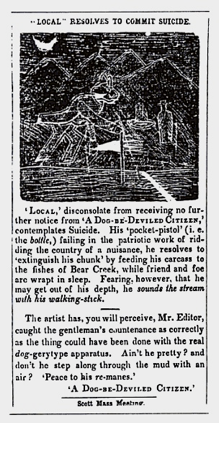May 5 Thursday – Orion once again left the Journal in Sam’s hands. Sam printed three stanzas of vernacular humor in verse “The Heart’s Lament,” dated May 4, under the pen name, “Rambler,” one he would use again in 1858 for the St. Louis Missouri Democrat. The rival Messenger paper was outselling the Journal, now a daily, and Sam was overburdened with getting the paper out. Brother Henry Clemens was a slow and careless typesetter, who probably didn’t like the work; Sam had to keep long hours to correct Henry’s errors [Wecter 257; ET&S 1: 88-90].
April 29 Friday – Two humorous pieces appeared in the Journal over the name “Rambler,” one a report of a stagecoach that crashed through a cellar, and the other a report that “some French gentleman or gentlemen” stole “two hams only” from Brittingham’s pork house [Wecter 257].
April 16 Saturday– The Journal printed an unsigned comic verse, “On Miss Anna Bread,” attributed to Sam [Camfield, bibliog.].
March, early – An accident at the Journal ruined several columns of type, as reported by the Messenger on Mar. 5. Orion announced the paper would now be a daily as well, to make up for lost editions, under the name the Hannibal Daily Journal [Benson 7].
January 23 Sunday – Sam gave a drunk some matches for his pipe. Later that night the drunk was arrested and jailed in a brick house by the river. At 2 AM the jail caught fire from the drunk’s pipe and people could only watch as the man burned to death. It was an episode that loaded more guilt on Sam, and in 1870 he recalled the death in a letter to his boyhood pal, Will Bowen: “we accidentally burned up that poor fellow in the calaboose” [MTL 4: 51]. Just how the fire started, no one could tell, yet Sam carried guilt from that episode his entire life. (Date calculated from Orion’s Jan.
November 30 Tuesday – Sam’s seventeenth birthday.
November 25 Thursday – Orion’s newspaper, the Hannibal Journal, commented on Joseph Ament’s sale of the Hannibal Missouri Courier:
[Ament’s ability had] made him an efficient supporter of his party principles, while his courtesy and uniformly manly course, procured him many friends among his opponents. We heartily wish him success wherever he may bend his steps, and in whatever business he may undertake —except making proselytes to his party [Benson 6]. Note: the two papers had been political rivals.
November 4 Thursday – “Conubial Bliss,” another unsigned sketch of Sam’s about a rowdy Irishman on “Holliday’s Hill” appeared in the Hannibal Journal [ET&S 1: 85]:
September 23 Thursday – “Blab’s Tour”; “Letter to ‘Mr. Editor’” byline Blab; “Letter to ‘Mr. Editor’” byline A Dog-be-Deviled Citizen,” [Camfield, bibliog.] and “‘Pictur’ Department,” were printed with additional thrusts at the Messenger’s “Local.” Orion returned; Blab announced, “I have retired from public life to the shades of Glascock’s Island” [Wecter 253; ET&S 1: 72-4]. Blab announced his final appearance in the Journal [ET&S 1: 83].
 September 16 Thursday – Sam satirized Josiah T. Hinton, the new editor of the competing Hannibal Tri-Weekly Messenger, in an article, “Local Resolves to Commit Suicide.” See insert. It seems Hinton had been a jilted lover, so went to the river one night to drown himself, but could not follow through.
September 16 Thursday – Sam satirized Josiah T. Hinton, the new editor of the competing Hannibal Tri-Weekly Messenger, in an article, “Local Resolves to Commit Suicide.” See insert. It seems Hinton had been a jilted lover, so went to the river one night to drown himself, but could not follow through.
Subscribe to
© 2026 Twain's Geography, All rights reserved.

 September 16 Thursday – Sam satirized Josiah T. Hinton, the new editor of the competing Hannibal Tri-Weekly Messenger, in an article, “Local Resolves to Commit Suicide.” See insert. It seems Hinton had been a jilted lover, so went to the river one night to drown himself, but could not follow through.
September 16 Thursday – Sam satirized Josiah T. Hinton, the new editor of the competing Hannibal Tri-Weekly Messenger, in an article, “Local Resolves to Commit Suicide.” See insert. It seems Hinton had been a jilted lover, so went to the river one night to drown himself, but could not follow through.